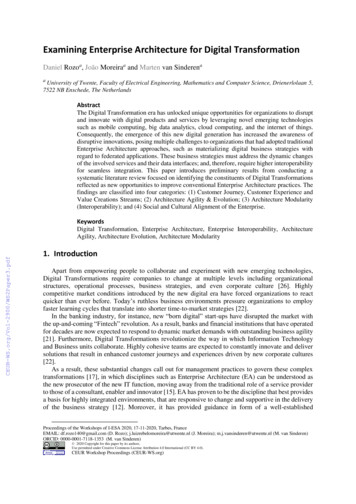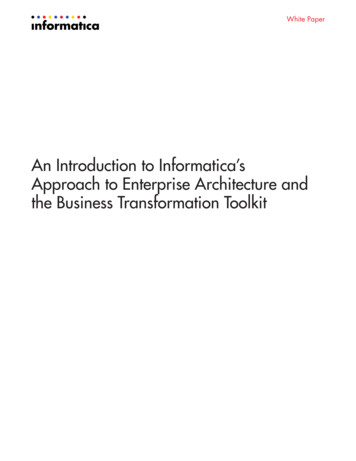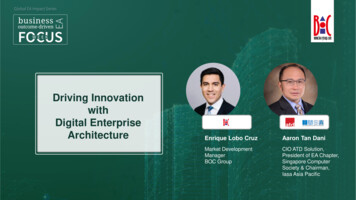
Transcription
Examining Enterprise Architecture for Digital TransformationDaniel Rozoa, João Moreiraa and Marten van SinderenaaUniversity of Twente, Faculty of Electrical Engineering, Mathematics and Computer Science, Drienerlolaan 5,7522 NB Enschede, The NetherlandsAbstractThe Digital Transformation era has unlocked unique opportunities for organizations to disruptand innovate with digital products and services by leveraging novel emerging technologiessuch as mobile computing, big data analytics, cloud computing, and the internet of things.Consequently, the emergence of this new digital generation has increased the awareness ofdisruptive innovations, posing multiple challenges to organizations that had adopted traditionalEnterprise Architecture approaches, such as materializing digital business strategies withregard to federated applications. These business strategies must address the dynamic changesof the involved services and their data interfaces; and, therefore, require higher interoperabilityfor seamless integration. This paper introduces preliminary results from conducting asystematic literature review focused on identifying the constituents of Digital Transformationsreflected as new opportunities to improve conventional Enterprise Architecture practices. Thefindings are classified into four categories: (1) Customer Journey, Customer Experience andValue Creations Streams; (2) Architecture Agility & Evolution; (3) Architecture Modularity(Interoperability); and (4) Social and Cultural Alignment of the Enterprise.Keywords 1Digital Transformation, Enterprise Architecture, Enterprise Interoperability, ArchitectureAgility, Architecture Evolution, Architecture Modularity1. IntroductionApart from empowering people to collaborate and experiment with new emerging technologies,Digital Transformations require companies to change at multiple levels including organizationalstructures, operational processes, business strategies, and even corporate culture [26]. Highlycompetitive market conditions introduced by the new digital era have forced organizations to reactquicker than ever before. Today’s ruthless business environments pressure organizations to employfaster learning cycles that translate into shorter time-to-market strategies [22].In the banking industry, for instance, new “born digital” start-ups have disrupted the market withthe up-and-coming “Fintech” revolution. As a result, banks and financial institutions that have operatedfor decades are now expected to respond to dynamic market demands with outstanding business agility[21]. Furthermore, Digital Transformations revolutionize the way in which Information Technologyand Business units collaborate. Highly cohesive teams are expected to constantly innovate and deliversolutions that result in enhanced customer journeys and experiences driven by new corporate cultures[22].As a result, these substantial changes call out for management practices to govern these complextransformations [17], in which disciplines such as Enterprise Architecture (EA) can be understood asthe new prosecutor of the new IT function, moving away from the traditional role of a service providerto those of a consultant, enabler and innovator [15]. EA has proven to be the discipline that best providesa basis for highly integrated environments, that are responsive to change and supportive in the deliveryof the business strategy [12]. Moreover, it has provided guidance in form of a well-establishedProceedings of the Workshops of I-ESA 2020, 17-11-2020, Tarbes, FranceEMAIL: df.rozo140@gmail.com (D. Rozo); j.luizrebelomoreira@utwente.nl (J. Moreira); m.j.vansinderen@utwente.nl (M. van Sinderen)ORCID: 0000-0001-7118-1353 (M. van Sinderen) ️ 2020 Copyright for this paper by its authors.Use permitted under Creative Commons License Attribution 4.0 International (CC BY 4.0).CEUR Workshop Proceedings (CEUR-WS.org)
governance instrument to consistently align business and IT with strategies and goals to ensureadaptability, consistency, compliance, and efficiency [25].However, organizations that have allocated resources and great efforts to become truly digital,criticize the EA practice as it fails to grasp the fundamental concepts from the nature of DigitalTransformations [11]. Organizations have developed an increasing reluctance to undertake massivearchitecture efforts, as the complexity from the EA practice prevents simple projects to adopt practicalsolutions and quick adaptations to change [18]. In addition, companies who have embarked on DigitalTransformation initiatives embrace the philosophy of “fail fast, learn fast” [21], allowing organizationsto speed-up their learning cycles and become truly agile instead of falling into the trap of committingto years-long EA plans with “Big Designs Up-Front” [22].Companies preparing for future digital disruptions are driving innovation through enhancedenterprise interoperability mechanisms [23]. Moreover, progressive journeys from monolithic tomodular architectures address interoperability issues e.g. the new European interoperability framework(EIF) as a facilitator of Digital Transformation for citizen empowerment [14], promoting theestablishment of well-architected digital ecosystems that characterize many digital business models[22]. The latter illustrates how Digital Transformation has begun to change the fabric of the EA practiceand introduce enhanced approaches that enable organizations stay ahead of competition while keepingup the pace of the new digital generation. Certainly, this situation has caught our attention to performthis research.1.1.Enterprise Architecture for Digital TransformationAccording to [7], “Digital Transformation can refer to anything from IT modernization (for example,cloud computing), to digital optimization, to the invention of new digital business models.” i.e. anoperation or exercise to leverage new digital technologies that enable major business improvements andinfluence all aspects of customers’ life [20].Digital Business Transformation on the other hand, is defined by [8] as “the process of exploitingdigital technologies and supporting capabilities to create a robust new digital business model”. Hence,stipulating a method of using technologies to structure changes and modifications of business processesand strategies of an organization to meet customer requirements and dynamic market demands.Further, [9] defines digitalization as “the use of digital technologies to change a business model andprovide new revenue and value-producing opportunities; it is the process of moving to a digitalbusiness”. In practice, digitalization comes down to how digital technologies allow computing to beimplemented into daily activities that traditionally were considered to be performed by human beings[26]. Finally, digitization is simply the conversion of any analog resources to digital form [15] e.g.converting a physical document from paper to a digital form.As depicted in Figure 1, a conceptual model illustrates the scope of the terminology previouslydiscussed, in the context of an organization and its extent in relation to EA. From a bottom-upperspective, digitization is implemented in the enterprise at the lowest level, where activities such asdigitization of information, provide the enterprise new ways to access and share data across all businessunits. EA provides a clear set of work to map these technological mechanisms in response to businessneeds.Digitalization initiatives focus on delivering projects and employ technology to automate, optimizeor modernize business operations and processes of the enterprise. As a result, architecture and solutionbuilding blocks guarantee the logical integration of these complex relationships to deliver enhanced ornew service capabilities.
Figure 1: Digital Transformation and Enterprise ArchitectureA vague distinction however, is made between the Digital Business Transformation and DigitalTransformation since both terms relate to disruptive changes of new business models through the useand exploitation of digital technologies. Consequently, these concepts are treated in this research simplyas Digital Transformation (DT) henceforth, as they both are conceived within the boundaries of theentire business or organization, include the integration of digitization projects to transform the businessand its own strategy, and finally yet importantly, portray the extension and effective reach of theenterprise through digital capabilities.1.2.Problem Definition and Research ObjectivesPreliminary observations from literature focused on EA in the context of Digital Transformationsuggest that EA approaches are delivered as stable mechanisms for value creation, while DigitalTransformations are characterized by context-sensitive value ecosystems [19]. In addition,organizations perceive EA and its related methodologies as complex, where strategy and processes areonly considered marginally and with an IT focus [11].As an example of complexity, EA has been criticized for providing “Big Designs Up-front”, whereconventional approaches impose rules and guidelines preventing simple projects to adopt practicalsolutions and quick adaptations to change [18].In contrast, the concept of Digital Transformation and its companying technologies enable afundamental reshaping of the businesses towards cross-functional, modular and distributed processes[2]. Not to mention that unlike the IT focus perspective characteristic of EA approaches, DigitalTransformations come from a business-centric perspective, focusing on the transformation of products,processes and organizational aspects due to the adoption of new emerging technologies [17].Ultimately, successful development and integration of Digital Transformation through digitalbusinesses requires a high degree of agility in enterprises [24]. However, well-established EAapproaches offer heavy and complex mechanisms with a vague perception of enterprise agility [11, 16,18].As a result, both these challenges and requirements have created a wide gap to deliver the expectedresults from EA approaches in the form of materialized Digital Transformations in organizations.Hence, the EA practice must cope with these by adopting new or enhanced building blocks that promoteconcepts such as architecture evolution, agility and modularity with context-sensitive value creationmechanisms. Therefore, the presented study intends to answer the following main research question.How can EA best provide a basis for Digital Transformation initiatives in organizations?Based on the main research question, sub-questions are formulated: RQ1: What constituents from Digital Transformation initiatives are not contemplated by theEA practice?
RQ2: What EA frameworks, methodologies, and techniques are available that best provide abasis for Digital Transformation? RQ3: How are companies from a specific industry (e.g. manufacturing) relying on EA to deliverDigital Transformations into the organization?2. Research Methodology and Preliminary ResultsThe Systematic Literature Review (SLR) performed for this study is based on the methodologyprovided by [10] for literature reviews in the Information Systems (IS) field. The four-phase methodwas applied to distinguish between the body of knowledge relevant for this review and the rest of theliterature that is not aligned to the purpose of this analysis.The scholarly literature search performed in this research aims to retrieve credible academic peerreview content from well-known sources of scientific knowledge. Databases and search engines forscientific literature used in this research include Scopus, SpringerLink, ScienceDirect, and IEEExplore.As part of the literature, recognized publications from large communities of practitioners in the fieldof EA were included in this literature study. Therefore, this research considers The Open Group standards related to EA as relevant sources of knowledge aligned to the interests and objectives of thisproject. MIS Quarterly Executive, as a further reliable source of practice-based research with the largestnumber of publications in the last years in the context of Digital Transformation, contributes to the bodyof knowledge of this SLR.Groundwork results that address RQ1 identify the following elements as the constructs that need tobe contemplated into the conventional way of undertaking EA efforts in relation to DigitalTransformation.2.1.Customer Journey, Customer Experience and Value Creation StreamsCustomer experience and project-to-product shifts are the major drivers for companies to embark ona Digital Transformation initiative. Architecture building blocks placed into adaptive operation modelsthat comply with both digital and agile transformations will translate into successful customer journeys[22]. Traditional EA methodologies focus on Information Systems for stable value chains and customerneeds, whereas digital transformation works with ecosystems and context-sensitive value creation [19].Organizations developing Digital Transformation initiatives should not only be prepared to embracecontinuous changes in business processes, information systems, and technology domains but also beaware of the value creation streams embedded into those domains to successfully materialize improvedcustomer journeys and experiences.2.2.Architecture Agility & EvolutionCurrent EA mechanisms are built to map complex structures in organizations that are perceived tobe moving at the same speed, however, reviewed studies highlight the importance of agility in terms ofmulti-level speeds across the architecture to successfully deliver Digital Transformation initiatives [3,13].On the other hand, EA is based on waterfall mechanisms whereas Digital Transformation relies onan agile approach, in other words, lifecycle phases adopted by EA include development-maintenancedocumentation, where agile adopts development-usage-maintenance-documentation [19]. In fact,concepts such as Minimum Viable Architectures [4] and Sacrificial Architectures [6] fosterexperimentation while accelerating the cycles of continuous innovation in organizations and embracethe fundamental principle of business agility from Digital Transformation endeavors.Ultimately, proposals and modifications to current EA approaches include designing effectiveadaptive operating models. Consequently, extensions of such models must support guided andincremental change across multiple dimensions of architectures that have no end state, i.e. evolutionaryarchitectures [5].
2.3.Architecture ModularityEasy ways to adopt architectures are also one of the main requirements from DT initiatives to EAapproaches. In order to undertake DT projects, EA approaches must think modular, cross-functionalwith distributed business processes that allow higher interoperability within and amongst ecosystems[11]. These particular ecosystems are self-contained and self-adjusting systems that when grouped theycreate value. “Modularity is about decomposing a system into parts that are loosely-coupled” [22],where the system is any type of entity from a human to social to technical. Thus, materializing a DigitalTransformation initiative through modularized architectures will bring flexible, adaptable and agileenterprises resilient to change while retaining value delivered to customers.2.4.Social and Cultural Alignment of the EnterpriseIn order to cope with agile and flexible ways to work, organizations embarking on DigitalTransformations projects are required to consider changes in roles and responsibilities across multiplebusiness units. These changes must be delivered consistently while considering systematic changes inprocesses, technology, and data. Understanding such associations is a challenge while factoringcomplexities of EA design, where aspects such as culture and social alignment should also be a priority[1].Digital Transformations transcend conventional architectural principles, striving organizations intonew ways of operating and most importantly, collaborating. EA approaches should absorb new DTdriven cultures across the entire enterprise and outline its relationships across actors, technology, data,and underlying business processes.3. Conclusions and Future WorkPreliminary results from this study show that the new era of Digital Transformation has brought anew set of challenges to today’s EA practice. Concepts such as architecture agility and evolution,architecture modularity, social and cultural alignment of the enterprise, and context-sensitive valuecreation models present solid foundations to reformulate current EA approaches for a clear journeytowards effective Digital Transformations.Current research efforts include the exploration of the state-of-art regarding EA frameworks,methods and techniques for DT (RQ2) and their applicability to industries e.g. manufacturing (RQ3).Future work will strive towards the adaptation of conventional EA practice to address therequirements of digital services regarding: (1) Customer Journey and Customer Experience; (2)Architecture Agility and Evolution; (3) Architecture Modularity (Interoperability); and (4) Social andCultural Alignment of the Enterprise.4. References[1] Z. Babar, E. Yu, Digital Transformation–Implications for Enterprise Modeling and Analysis, in:2019 IEEE 23rd International Enterprise Distributed Object Computing Workshop (EDOCW),IEEE, 2019, pp. 1-8. doi: 10.1109/EDOCW.2019.00015.[2] A. Bharadwaj, O. A. El Sawy, P. A. Pavlou, N. Venkatraman, Digital business strategy: toward anext generation of insights. MIS Quarterly 37 (2013) 471-482. doi: 10.25300/MISQ/2013/37:2.3.[3] O. Bossert, A two-speed architecture for the digital enterprise, in: E. El-Sheikh, A. Zimmermann,L. Jain (Eds), Emerging Trends in the Evolution of Service-Oriented and Enterprise Architectures,Intelligent Systems Reference Library, volume 111, Springer, Cham, 2016, pp. 139-150.doi:10.1007/978-3-319-40564-3 8.[4] M. Erder, P. Pureur, Continuous Architecture: Sustainable Architecture in an Agile and CloudCentric World, Elsevier Science, 2016.[5] N. Ford, R. Parsons, P. Kua, Building evolutionary architectures: support constant change. O'ReillyMedia, Inc., 2017.
[6] l[7] chnology/glossary/digital-transformation.[8] 9] hnology/glossary/digitalization.[10] O. Gaß, K. Ortbach, M. Kretzer, A. Maedche, B. Niehaves, Conceptualizing Individualization inInformation Systems-A Literature Review, Communications of the Association for InformationSystems 37 (2015) 64-88. doi10.17705/1CAIS.03703.[11] D. Goerzig, T. Bauernhansl, Enterprise architectures for the digital transformation in small andmedium-sized enterprises. Procedia CIRP 67 (2018) 540-545. doi: 10.1016/j.procir.2017.12.257[12] R. Harrison, Togaf (r) 9 Foundation Study Guide, Van Haren, 2018.[13] B. Horlach, P. Drews, I. Schirmer, Bimodal IT: Business-IT alignment in the age of digitaltransformation, Multikonferenz Wirtschaftsinformatik (MKWI), 2016, pp. 1417-1428.[14] A. Kouroubali, D.G. Katehakis, The new European interoperability framework as a facilitator ofdigital transformation for citizen empowerment, Journal of biomedical informatics 94 (2019). doi:10.1016/j.jbi.2019.103166.[15] C. Legner, T. Eymann, T. Hess, C. Matt, T. Böhmann, P. Drews, A. Mädche, N. Urbach, F.Ahlemann, Digitalization: opportunity and challenge for the business and information systemsengineering community, Business & information systems engineering 59 (2017), 301-308. doi:10.1007/s12599-017-0484-2.[16] Y. Masuda, M. Viswanathan, Enterprise Architecture for Global Companies in a Digital IT Era:Adaptive Integrated Digital Architecture Framework (AIDAF), Springer, 2019.[17] C. Matt, T. Hess, A. Benlian, Digital transformation strategies, Business & Information SystemsEngineering, 57 (2015), 339-343. doi: 10.1007/s12599-015-0401-5.[18] O. F. Nandico, A Framework to Support Digital Transformation, in: E. El-Sheikh, A.Zimmermann, Lakhmi C. Jain (Eds.), Emerging Trends in the Evolution of Service-Oriented andEnterprise Architectures, volume 111 of Intelligent Systems Reference Library, Springer, Cham,2016, pp. 113-138. doi: 10.1007/978-3-319-40564-3 7.[19] D. Őri, Z. Szabó, EAM Based Approach to Support IT Planning for Digital Transformation inPublic Organizations, in: European Conference on Advances in Databases and InformationSystems, 2018, pp. 377-387.[20] J. Reis, M. Amorim, N. Melão, P. Matos, Digital transformation: a literature review and guidelinesfor future research, in: Á. Rocha, H. Adeli, L. P. Reis, S. Costanzo (Eds.), Trends and Advancesin Information Systems and Technologies, volume 745 of AISC, WorldCIST'18, Springer, Cham,2018, pp. 411–421. doi: 10.1007/978-3-319-77703-0 41.[21] S. K. Sia, C. Soh, P. Weill, How DBS Bank Pursued a Digital Business Strategy, MIS QuarterlyExecutive 15 (2016) 105-121.[22] The Open Group, The Open Group Agile Architecture Framework Draft Standard: The OpenGroup Snapshot, The Open Group, 2019.[23] P. Weill, S.L. Woerner, Thriving in an increasingly digital ecosystem, MIT Sloan ManagementReview 56 (2015) 27-34[24] M. Wißotzki, K. Sandkuhl, The digital business architect–towards method support for digitalinnovation and transformation, in: IFIP Working Conference on The Practice of EnterpriseModeling, PoEM 2017, Springer, Cham, 2017, pp. 352-362. doi: 10.1007/978-3-319-70241-4 24.[25] A. Zimmermann, R. Schmidt, K. Sandkuhl, M. Wißotzki, D Jugel, M. Möhring, Digital enterprisearchitecture-transformation for the internet of things, in: 2015 IEEE 19th International EnterpriseDistributed Object Computing Workshop. 2015, pp. 130-138. doi: 10.1109/EDOCW.2015.16.[26] A. Zimmermann, R. Schmidt, K. Sandkuhl, D. Jugel, J. Bogner, M. Möhring, Evolution ofenterprise architecture for digital transformation, in: 2018 IEEE 22nd International EnterpriseDistributed Object Computing Workshop (EDOCW), 2018, pp. 87-96. doi:10.1109/EDOCW.2018.00023.
Enterprise Architecture for Digital Transformation According to [7], "Digital Transformation can refer to anything from IT modernization (for example, . and its own strategy, and finally yet importantly, portray the extension and effective reach of the enterprise through digital capabilities. 1.2. Problem Definition and Research Objectives










